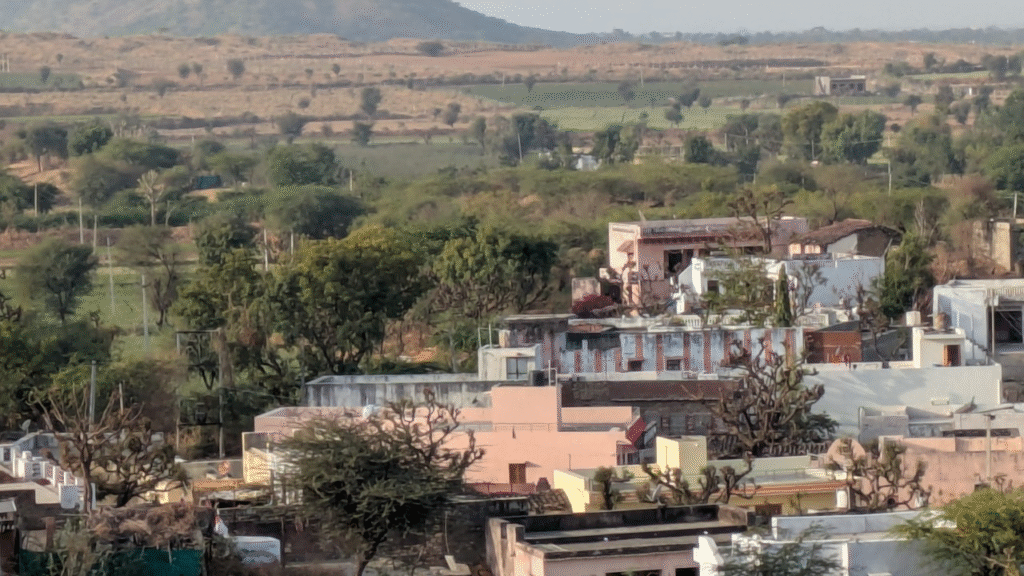
There’s something deeply liberating about a long road journey — the kind that lets you set your own pace, veer off the beaten track, and stop wherever a curious turn or a sudden hunger pang beckons. It’s the kind of freedom only the open road offers, and we’ve always been drawn to it.
On February 20, we set off on such a journey — 475 kilometers from Ahmedabad to Sadakmaliya, a small hamlet of about 200 families nestled in the Pali district of Rajasthan. But this wasn’t just another road trip. This one carried the weight of anticipation and affection. Prabhu, who has been a part of our family for over two and a half decades, hails from Sadakmaliya. He had recently expanded and renovated his ancestral home and was eager — almost glowing with pride — for us to see it. His excitement proved infectious. Before we knew it, the journey was on the calendar.
The Preparations
The travel party included Alka and me, Prabhu — the proud host and designated driver —Ashok, who looks after us in Ahmedabad, and Bipin, our dependable manager from Goa, who happened to be in town. Spirits were high, and so was our ambition: leave by 9 AM, reach the village before sunset, and soak in the countryside along the way.
In a burst of bravado, we decided not to carry any food. “We’ll live off the road,” we declared with misplaced confidence. That resolve, however, crumbled faster than a dry khakhra. The day before departure, Alka made a stealth visit to Falguni, our favorite Gujarati snack shop, returning with a bag brimming with irresistible goodies. Not to be outdone, Ashok’s wife — clearly skeptical of our survival instincts — packed homemade samosas and dhoklas. By the time we loaded up our large SUV, we had enough food to feed a small army. So much for minimalism!
The First Stop – Mehsana
With our SUV bursting with snacks and enthusiasm, we set off. Prabhu took the front seat, beaming with the pride of a man about to show off his roots. As we slowly crawled through Ahmedabad’s morning traffic and finally hit the Ahmedabad – Palanpur highway, the mood shifted into that magical road trip rhythm: music, laughter, and the open road.
Oddly enough, the moment there’s food in the car, hunger strikes early. Despite a hearty breakfast, the aroma of samosas and dhoklas teased our senses. By 10:15 AM, just 50 kilometers in, we stopped at Mehsana. We parked opposite Shanku’s Water Park, in front of a modest shopping complex, and indulged ourselves. Sitting by the roadside with steaming chai in paper cups and greasy fingers clutching flaky samosas and fluffy dhoklas, we relished the first unofficial “meal off the road.” Even Prabhu, who normally avoids eating while driving to prevent drowsiness, couldn’t resist. Clearly, our no-food policy was a delicious failure.
En Route to Lunch – Laughter, Landmarks, and Life Lessons
Bellies full and laughter echoing, we rolled on. The car turned into a moving storytelling pod. Memories of past road trips came alive — especially those with our beloved Labrador, Tito, who had once marked his territory at every stop.
As miles flew past, the next big question arose: “Where do we stop for lunch?” Prabhu, ever-reliable and familiar with the route, had the perfect answer: Hotel Baba Ramdeo in Swaroopganj, a rustic highway-side eatery famed for authentic Rajasthani fare. “Is it owned by Baba Ramdev, the yoga guru?” I asked, half-serious. “No, no,” Prabhu chuckled, “This Baba Ramdeo is different – less yoga, more bajra roti!”
Roughly 150 kilometers from Mehsana, Swaroopganj would be the perfect pitstop around 1 PM. And with that decision made, the car turned into a mobile theatre of amusement.
The true stars of this leg of the journey were the trucks – moving billboards of philosophy and humor. Painted in vibrant hues, they wore their wisdom (and wit) with pride. Some were patriotic: “Mera Bharat Mahan” (My India is Great). Others, spiritual: “Ma Ka Aashirwad” (Mother’s Blessing). And then, the real gems:
- “Chutiyon Ki Rai Kabhi Mat Lena, Pachhtayega” (Don’t take advice from idiots — you’ll regret it).
- “Khushi Naseeb Se, Waqt Se Pehle Kabhi Nahi Milti” (Happiness doesn’t come before its destined time).
- “Hans Mat Pagli, Pyar Ho Jayega” (Don’t smile, silly girl — you might fall in love).
Each blurb evoked giggles, debate, and discussion as our playlist — an eclectic mix of old and new Hindi film songs — played in the background.
The Changing Landscape
The changing landscape narrated its own story. We cruised past Unjha, the country’s jeera (cumin) capital, with the air almost smelling of the spice! Then came Sidhpur, steeped in spiritual history with its sacred Bindu Sarovar, one of India’s five most revered lakes. A little further, Palanpur — final frontier of Gujarat — unfurled, known both for its stunning Jain temples and as the cradle of the global diamond trade, thanks to its enterprising Palanpuri Jain community.
As we crossed into Rajasthan, a transformation was instantly visible — not just in the terrain, but in the culture. The highway, previously dry and austere, suddenly sprouted liquor shops in abundance — a stark reminder that Gujarat is a prohibition state, while Rajasthan is not. It was barely noon, but we saw eager patrons pulling over for their weekend dose of cheer.
Soon, Abu Road flashed past — the gateway to Mount Abu’s misty hills. And right on schedule, by 1:15 PM, we pulled into Hotel Baba Ramdeo at Swaroopganj, hungry not just for food but for more stories, more color, and more of this joyfully unpredictable journey to Sadakmaliya.

The Sumptuous Lunch
By the time we stepped into the restaurant at Hotel Baba Ramdeo, the sun was high and our appetites even higher. The menu was no less than an epic — pages and pages of Rajasthani delights, each item flaunting its picture like a contestant in a beauty pageant. Everything looked tempting, but after much deliberation (and a bit of drooling), we placed our bets on three local stars: Tukkad Roti, Baingan Bharta, and Gatte Ka Pulao.
Tukkad Roti — also known as Khoba Roti — is not your everyday bread. It’s a hearty, rustic flatbread made with coarse whole wheat flour, sometimes spiced with ajwain (carom seeds), and always bathed in ghee. Gatta, on the other hand, is a Rajasthani classic — spiced gram flour dumplings cooked in a rich, curried gravy, and in this case, woven into a fragrant pulao speckled with cashew nuts.
Soon, a server appeared carrying what looked like a large, ceremonial platter. The Tukkad Roti, almost 12 inches across and nearly half an inch thick, sat proudly in the center — like a sun on a steel thali. What followed could only be described as a performance.
With the precision of a street magician, the server produced a short, sharp knife and a small tumbler brimming with molten ghee. First, he stabbed the roti’s golden-brown surface repeatedly, making deep incisions across its face. Then came the pièce de resistance — he slowly poured the molten ghee over the roti, letting it sink into every crack and crevice until the bread gleamed like polished bronze. With practiced hands, he sliced the roti into four quarters and placed one on each of our plates. (Prabhu, our disciplined driver, solemnly abstained.)
We stared, wide-eyed and reverent, as the ghee-soaked roti met its soulmates — smoky, tangy baingan bharta and the rich, cashew-studded gatte ka pulao. The roti’s crisp edges gave way to a soft, crumbly center that soaked up the baingan like a sponge. Every bite was a celebration of texture and taste – earthy, spicy, indulgent.
To seal the deal, we ended our feast with kulfi, the thickened milk dessert that, in my opinion, leaves most modern ice creams in the dust. Creamy, dense, and just sweet enough, it was the perfect finale to a royal spread.
Poor Prabhu could only watch and sip his cup of tea, stoically resisting the seductive aromas swirling around him. The man’s self-control deserved a standing ovation.
The Last Stretch
Bellies full and minds mellow, we resumed our journey. The road ahead beckoned, and the pace picked up with purpose — we were in the home stretch. We zipped past Sirohi, known as Dev Nagari — the City of Gods — thanks to the sheer number of temples dotting the district. Then came Pali, a town rich in culture and history, famous for its textile industries and the Bangur Museum with its collection of ancient coins, costumes, and artifacts.
Our next milestone was Sojat City, better known as Mehndi City. It supplies over 90% of India’s henna — a fact made apparent by the green-tinted shops and billboards dedicated to every imaginable mehndi product. From there, we continued to Sojat Road, where we left the highway and veered eastward onto a narrow, two-lane village road.
The landscape began to change. The highways gave way to dusty village road flanked by fields, grazing cattle, and curious villagers. We passed through Dhundhla, Musaliya, and Kantaliya, each village quietly unfolding its rhythms of rural life.
And then, just as the golden sun began its descent, we arrived home at 5:30 PM.
Waiting at the doorstep were Leela, Prabhu’s wife and their son, Yash to welcome us. We sat on charpaees (cots) in the spacious quadrangle in front of the house, with our feet up, against the setting sun, enjoying hot cups of tea and palak pakodas (spinach fritters), as we relived the wonderful moments of our journey through the heartland of the two Western states in India.
#Pali #Sirohi #Sadakmalia #Rajasthan #Roadtrip #Gujarat #Palanpur #Blurbs #RuralIndia #HotelBabaRamdeo
